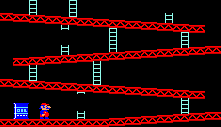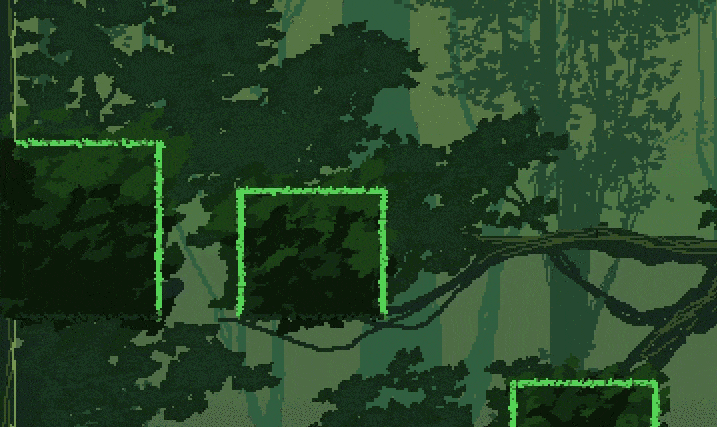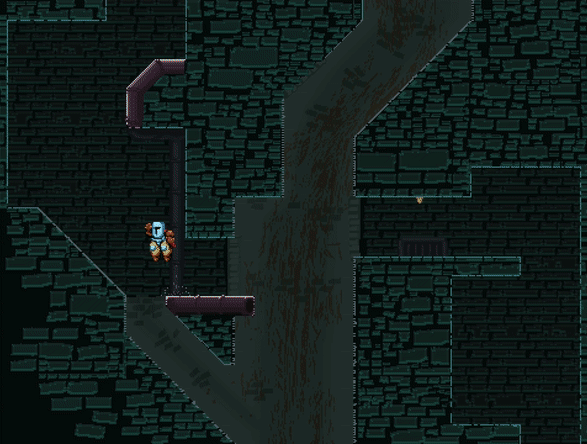Minimalism in Games and Jump King
Originally published January 19, 2020.
Minimalism, according to Wikipedia (2004), is work that sets out to expose the essence, essentials or identity of a subject through eliminating all non-essential forms, features or concepts. It varies in intention and effect from artist to artist, and from medium to medium. It’s a process, of one work or a movement, of refinement and simplification, where something known is deconstructed and its non-essential elements removed. Fundamentally it is subtractive – yet when it works, what remains is given such power that it can easily overshadow any work that focuses instead on addition. Think about a single brush stroke. The mix of paints, the unique texture, the representation of one deliberate motion. But most paintings have hundreds of strokes littering their canvases, and the beauty inherent to each one is overwhelmed by this pure quantity.

Calm Sea by Leonid Afremov (2013).
Donald Judd (1965) details a new form of object that to him differs from paintings and sculpture, summarizing what makes minimalism work: “In the three-dimensional work the whole thing is made according to complex purposes, and these are not scattered but asserted by one form. It isn’t necessary for a work to have a lot of things to look at, to compare, to analyze one by one, to contemplate. The thing as a whole, its quality as a whole, is what is interesting. The main things are alone and are more intense, clear and powerful.” Throughout all of minimalism is this focus on relativity – minimalistic art is compared to more complex, nuanced and unfocused works. Minimalism isn’t some inherent quality, but something that exists in contrast to the other. In games, I think the best example of this is Justin Smith’s Desert Golfing (Blinkbat Games, 2014), which doesn’t even have a menu screen – it’s just you, the ball, and the hole, golfing in the desert. It’s the only golf game I like, because it’s the only one that isn’t a pale imitation of the real-life sport. This isn’t the game I’ll focus on here however, in part because it is already covered so extensively by Tevis Thompson in his post on The Existential Art (2015), and in part because there’s a mechanic that is too interesting to be ignored in this context.

I started by calling attention to the brush stroke and its simple beauty. Now, think about the jump. The tension, drama, and importance of the jump cannot be overstated. Jumpman would later become Mario, the first avatar to jump and a mascot to all of gaming. Of all the games that came since in the Mario franchise, it’s 1981’s Donkey Kong (Nintendo) whose jump I find has the most intensity and power. This isn’t to say Mario, and his jumping, has not developed remarkably: from humble beginnings in Donkey Kong and Mario Bros., up through Super Mario Bros., SMB3 and Yoshi’s Island, and finally making a spectacular jump to 3D in Super Mario 64 (and that’s just the main series). But, at least until the translation to 3D, they all add rather than subtract. More jumps, more obstacles, more plot, more minigames, more verbs. The individual jumps matter less and less. Donkey Kong could be called minimalistic in retrospect, though it had no minimalistic intentions behind it – if seen as a progression on Space Panic (Universal Entertainment Corporation, 1980) it is the opposite, adding a jump and more kinds of levels. Compare this to Getting Over It With Bennett Foddy (Foddy, 2017). While it doesn’t have jumping, it does have wonderfully tense, beautifully simple platforming. It has one mechanic, one verb: moving the hammer. Celia Wagar (2019) does a good job of breaking down the amount of depth that is achieved by just this one mechanic in Cultivating Possibility Space. Then again, there is nothing like it – it has nothing to distil, no starting point from which it strips away and subtracts to achieve a more pure and focused end result. It’s minimal, but not even restrospectively is it truly minimalistic.

Enter Jump King (Nexile, 2019). It’s inspired by Getting Over It, but with a more traditional platforming style: the hammer and pot are no more, replaced by the classic jump. Besides this is also the decade-old Canabalt (Saltsman, 2009), inventor of the endless runner subgenre. Together, they represent everything that a jump is and can be, and little to no more. They both strip away anything that doesn’t help convey this, leaving the player to face the inherent beauty and power of the mechanic at the core of so many games. Canabalt is always moving, never giving you room to think, demanding action. Jump King is static, putting the onus on you to act, inviting deliberation. Every meaningful jump is a result of deliberate thought, quick action, or a mix of both. However, the endless runner was inevitable and a short distance from what platformers already were – Jump King stands out as a much bigger divergence from standard platforming design with its slower pace. Through this, however, the game distils jumping platformers (which is most platformers) to their purest essence. Canabalt isn’t minimalistic in this same sense, it’s a bit more of a simplification and doesn’t gain anything specific from the changes it does. So, what is the essential experience of platforming, of jumping?
Breaking down the process of jumping, I’d say there’s 4 distinct steps. (1) You see an obstacle before you, (2) simulate in your head how the mechanics will function to bypass it, (3) consider any consequences and modifiers (enemies, the punishment for failing the jump, what the next obstacle is if you can see it) to adjust your plan, and (4) make the jump according to it. If you end up failing, you may also have an epilogue of reacting to mitigate the punishment or even turning failure into success, like moving to avoid an attack you didn’t see coming or grabbing onto the side of a platform to wall jump to safety. In most games this is internalized and automatic, if not to start then certainly by a ways in, but Jump King allows the player no such comfort until they have really mastered the game and its jumps. No two obstacles are the same – each one is different either in what you can collide with, how far and high you need to jump, how big the margin of error is, and/or how far you will fall. Later areas and the DLCs also have various environmental effects like wind or snow to mix it up without ever becoming mere gimmicks.
Two aspects are key to take advantage of this. First is that there are no checkpoints, no safe areas. Some jumps will have very little punishment, while others will be a chokepoint where you either get to progress on in the area or fall far down – often to another chokepoint, which it may be a while since you were at, and maybe you’re tilted from your failure, and maybe you only passed it on a fluke last time, so you’re more likely to fail and fall even further. This is the aspect shared with Getting Over It, though Jump King focuses more on learning the jumps and less on learning the movement mechanics. I tried to illustrate here, though it doesn’t communicate it too well. Second is that you cannot control the character mid-air – once you let go of jump, that is it. You still have control of how far you jump as opposed to Donkey Kong or Castlevania (Konami, 1986), but all inputs to control it are done strictly before jumping: charging it up and going left, straight up, or right. This means you can never react and correct as you see how things are going, you can’t jump higher than needed and then just stop your momentum to hit the platform regardless. Overshooting or undershooting, with each their different punishments, are concerns always on your mind, and the build-up to letting go of the jump button is palpable. The jump’s arc and the character’s slowdown when boucing off a wall serve to complicate how jumps can go and create more options for how to do each one – mainly more ways to fail and fall.

Since these jumps are not one-and-done deals, risking a fall to figure out a safer strategy is likely worth it, investing you in continuing to improve the jump after you’ve made it. You’re always planning, testing a new set-up or way to think about the timing that makes it easier to do it consistently, less punishing if you fail, more time efficient, and/or saves you from doing jumps by skipping over entire platforms. Many jumps will become entirely safe as you figure out how to do a full power jump consistently, but even then, as you get intimately familiar with the timings of the jump, and knowing you may still have to do this jump a dozen more times, you are tempted to save some time by cutting it as short as possible without falling. And if you embrace their safety, that only creates a more stark contrast to the jumps that are always unsafe, tense and even scary. With a varying meaning to efficiency, in my experience it will rarely happen for the second step, simulating the jump in my head, to be skipped entirely; or for the third step, planning my jump, to become automatic as it becomes in so many other games – at the minimum, the punishing nature of the game ensures that the first time you get to a jump, you will stop to look, even if that same jump may get less deliberate after you do it tens of times. Recklessness and sloppiness will rarely be rewarded, and playing half-assed reveals this quickly – sub-optimal strategies stagnate, and simple jumps are failed without learning anything from that failure. The speedrunning community for the game is testamount to how much room there is for optimization, and how far from the ideal strategies lazy players will settle. I’ve already touched on step 4 – the execution is always thoughtful and deliberate, since you cannot correct once you commit to the jump. Only the ice area gives you any control past making the jump, and even there that’s to make your falls less devastating rather than turning failure into success, so the optional epilogue is mostly absent.
This all comes together to continuously lead you through the essential experience of platforming. A great description of what this is like can be found in Razbuten’s video What Games Are Like For Someone Who Doesn’t Play Games (2019), around a minute in. He relays the experience of his wife playing Hollow Knight (Team Cherry, 2017) for the first time, having only played a little bit of Crash Bandicoot and Mario Cart before.
“Every moment, regardless of how seemingly insignificant, had a strange sort of intensity to it. For example, in the tutorial there are a set of platforms that the player needs to jump across. The only penalty for falling is a little bit of time and on my first playthrough, I breezed past it and immediately forgot about it. For her, it was intense beyond belief. She wasn’t sure what the penalty for falling would be, and she didn’t have a full grasp on how to adjust her jump height and distance. Each successful jump felt like a triumph. And after landing, she’d look out at the next platform, searching for the nerve to jump again.”
This is one of the most accurate descriptions of Jump King I’ve heard, and it doesn’t require you to be unfamiliar with platformers or games to provide this. There’s much writing on why jumping is fun, but few games really focus in on it to highlight this inherent quality without distractions. Many games, from Donkey Kong to Ori and the Blind Forest (Moon Studios, 2015), will showcase it here and there, and new players will face it in the beginning as they don’t yet have the skills to automate and ignore the various steps. But Jump King reckons with it directly and throughout the entire experience, distilling platforming into an experience that we don’t even recognize because it is so fundamental to an entire, huge genre. It may appear as a simplistic affair, all bravado and proud masochism, but Jump King at its core is truly extraordinary.
Game Methods
I played Jump King on PC before any DLC, and beat the game in 9 hours (12763 jumps and 1222 falls). I then replayed the early parts, getting up to Bargainburg in 4 minutes with 8 falls. I’m currently playing the DLC, but hadn’t touched it when I wrote this article.
References
BLINKBAT GAMES. (2014). Desert Golfing.
FODDY, B. (2017). Getting Over It With Bennett Foddy.
JUDD, D. (1965). Specific Objects. Accessed on 25.12.2019 from: http://atc.berkeley.edu/201/readings/judd-so.pdf.
KONAMI. (1986). Castlevania.
LEONID AFREMOV. (2013). Calm Sea.
MOON STUDIOS. (2015). Ori and the Blind Forest. Microsoft Studios.
NEXILE. (2019). Jump King.
NINTENDO. (1981). Donkey Kong.
RAZBUTEN. (2019). What Games Are Like For Someone Who Doesn’t Play Games. Accessed on 25.12.2019 from: https://www.youtube.com/watch?v=ax7f3JZJHSw.
SALTSMAN, A. (2009). Canabalt.
TEAM CHERRY. (2017). Hollow Knight.
THOMPSON, T. (2015). The Existential Art. Accessed on 25.12.2019 from: http://tevisthompson.com/the-existential-art/.
UNIVERSAL ENTERTAINMENT CORPORATION. (1980). Space Panic.
WAGAR, C. (2019). Cultivating Possibility Space. Accessed on 25.12.2019 from: https://critpoints.net/2019/05/03/cultivating-possibility-space/.
WIKIPEDIA. (2004). Minimalism (Visual Arts). Accessed on 25.12.2019 from: https://en.wikipedia.org/wiki/Minimalism_(visual_arts). Last edited on 22 September 2019.


Comments
Post a Comment